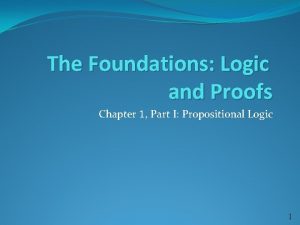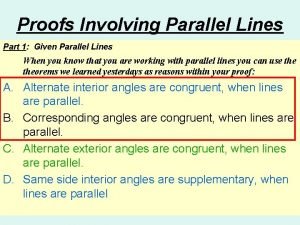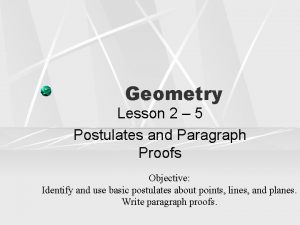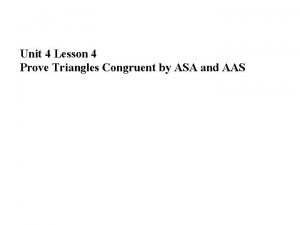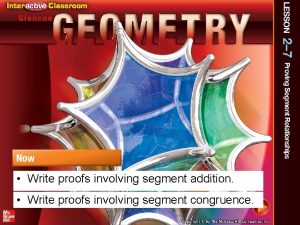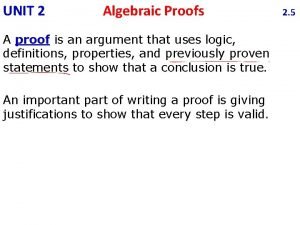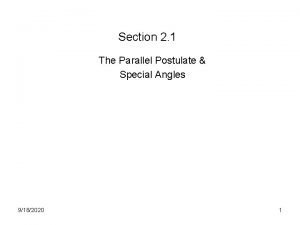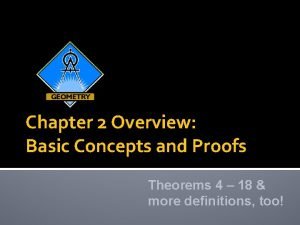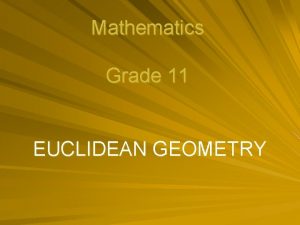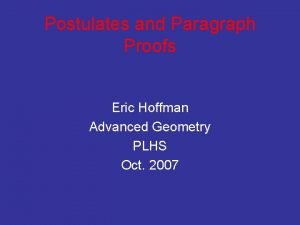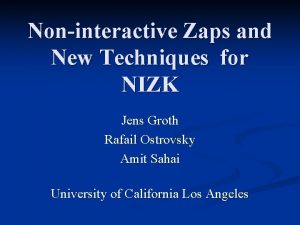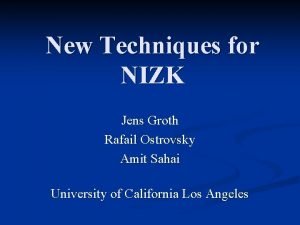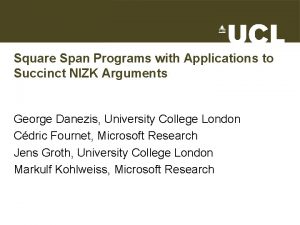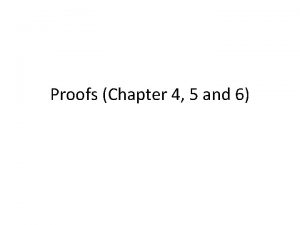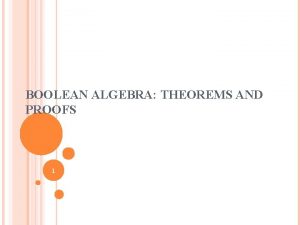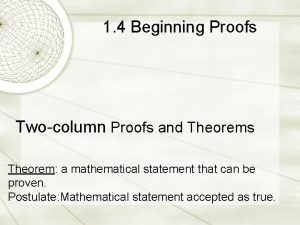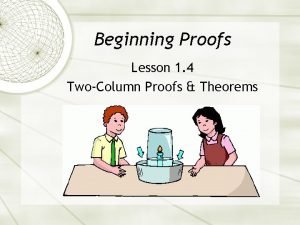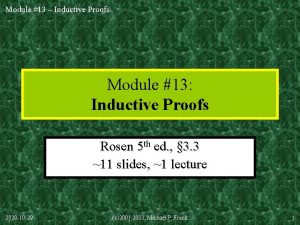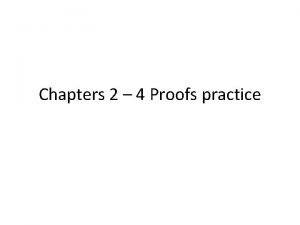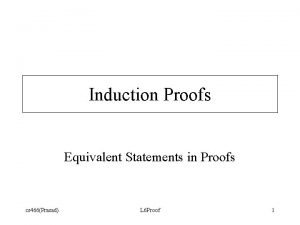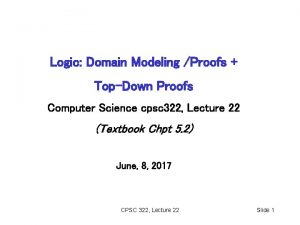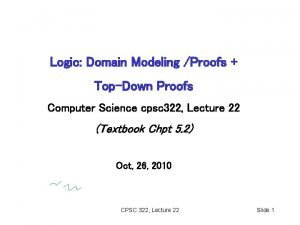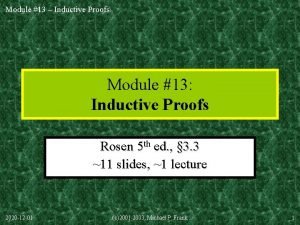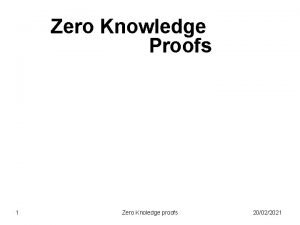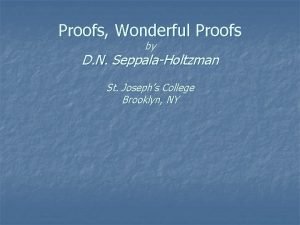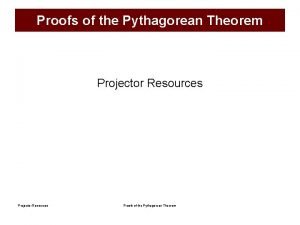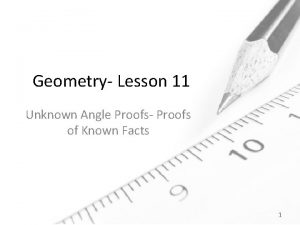Simulationsound NIZK Proofs for a Practical Language and




![BBS-encryption [BBS 04] Public key: f, h, g Secret key: x, y so f BBS-encryption [BBS 04] Public key: f, h, g Secret key: x, y so f](https://slidetodoc.com/presentation_image_h2/9ce587a7e1d35931af6a461c2fd73916/image-5.jpg)
![Security assumption Decisional linear assumption [BBS 04]: f, h, g, fr, hs, gt Hard Security assumption Decisional linear assumption [BBS 04]: f, h, g, fr, hs, gt Hard](https://slidetodoc.com/presentation_image_h2/9ce587a7e1d35931af6a461c2fd73916/image-6.jpg)

















- Slides: 23

Simulation-sound NIZK Proofs for a Practical Language and Constant Size Group Signatures Jens Groth University of California Los Angeles Presenter: Eike Kiltz, CWI

Overview Group signatures Simulation-extractable NIZK for PPEs Digital signatures RCCA-secure encryption NIZK proofs for Pairing Product Equations Groups with bilinear map

Bilinear groups G, GT cyclic groups of prime order p g generator for G Bilinear map e: G G GT e(ga, gb) = e(g, g)ab e(g, g) generator for GT

El. Gamal encryption fails Public key: g, h Encrypt message m: (u, v) = (gr, hrm) Not semantically secure, can for instance tell whether ciphertext (u, v) contains 1: e(u, h) = e(gr, h) = e(g, h)r= e(g, hr) e(g, v) = e(g, hrm)
![BBSencryption BBS 04 Public key f h g Secret key x y so f BBS-encryption [BBS 04] Public key: f, h, g Secret key: x, y so f](https://slidetodoc.com/presentation_image_h2/9ce587a7e1d35931af6a461c2fd73916/image-5.jpg)
BBS-encryption [BBS 04] Public key: f, h, g Secret key: x, y so f = gx, h= gy Encrypt message m: (u, v, w) = (fr, hs, gr+sm) Decrypt (u, v, w): m = w u-1/x v-1/y
![Security assumption Decisional linear assumption BBS 04 f h g fr hs gt Hard Security assumption Decisional linear assumption [BBS 04]: f, h, g, fr, hs, gt Hard](https://slidetodoc.com/presentation_image_h2/9ce587a7e1d35931af6a461c2fd73916/image-6.jpg)
Security assumption Decisional linear assumption [BBS 04]: f, h, g, fr, hs, gt Hard to distinguish tuples with t = r+s from tuples with t random Generalization of DDH (s = 0)

Example: verifiable encryption Public key: f, h, g Encryption of message m: (u, v, w) = (fr, hs, gr+sm) Statement ”m is plaintext of (u, v, w)”: e(u, h) = e(f, x) e(wm-1, h) = e(g, xv) Witness for satisfiability: x = hr

Pairing product equations Equation over variables x 1, . . . , xn eki fki ke(ak ixi , bk ixi ) = 1 for constants ak, bk G , eki, fki Zp Length of pairing product equation: k=1, . . . , l Earlier example, equation over x: e(u, h) = e(f, x) ↔ e(ux 0, hx 0)e(fx 0, x-1) = 1

Satisfiability of pairing product equations Given a set of pairing product equations S = {eq 1, . . . , eqm} over variables x 1, . . . , xn Satisfiability of pairing product equations: Does there exist a choice of x 1, . . . , xn G so all m equations are satisfied?

Satisfiability of pairing product equations • Relations between group elements • Direct expression, no reduction to Circuit SAT ! • At the same time very general: From S 1, . . . , SL can construct SAND: All Si simultaneously satisfiable SOR: Exists Si that is satisfiable NP-complete

NIZK Proofs Common reference string: crs Statement: S satisfiable Witness x 1, . . . xn Prover Soundness: NP-language valid proof →S satisfiable Zeroknowledge: S satisfiable, but I learned Verifier nothing else

NIZK proof for satisfiability of pairing product equations n n Perfect completeness, perfect soundness and computational zero-knowledge Common reference string: 6 group elements NIZK proof for set S = {eq 1, . . . , eqm} with total length L = l 1+. . . +lm over variables x 1, . . . , xn: 4 n + 228 L - 3 m group elements In other words: O(1) size crs, O(n+L) size proofs

Main technical contribution NIZK proof for a practical language: Satisfiability of pairing product equations Consequences: Efficient simulation-extractable NIZK proofs Group signatures with constant

Overview Group signatures Simulation-extractable NIZK for PPEs Digital signatures RCCA-secure encryption NIZK proofs for Pairing Product Equations Groups with bilinear map

Zero-knowledge S 1(1 k) ”Common reference string” sk Set of PPEs S Witness x 1, . . . , xn S 2(crs, sk, S) Simulator 0/1 Proof π Adversary Computational zero-knowledge: Pr[A 1|Simulated proofs (S 1, S 2)] ≈ Pr[A 1|Real proofs (K, P)]

Simulation-soundness S 1(1 k) sk ”Common reference string” Set of PPEs S S 2(crs, sk, S) Simulator (S, � ) Proof π Adversary Simulation-soundness Pr[ A (S, � ) so valid proof (S, � ) Q, S unsatisfiable] 0

Simulation-extractability SE 1(1 k) sk, xk S 2(crs, sk, S) Simulator ”Common reference string” Set of PPEs S (S, � ) Proof π Adversary Simulation-extractability Pr[ A (S, � ) so valid proof (S, � ) Q, E 2(xk, S, � ) ≠ w] 0

Simulation-extractable NIZK n n Simulation-extractable NIZK proof for satisfiability of pairing product equations CRS: O(1) group elements Proofs: O(n+L) group elements Comparison for Circuit SAT: Our proof size: O(|C|k) bits Previous: O(|C|k + poly(k)) bits

Group signature gpk Gro up m anag Anonymous er c Group manager an o pen/ trac e Signature on m Group members

Group signature Group public key: vkcert, pkcpa, crs Group manager’s join key: skcert Group manager’s open key: dkcpa Join user i: User: keys GM: (vki, ski) ← CMA-secure signature certi ← signskcert(vki) User i’s public key: vki, certi

Group signature Group public key: vkcert, pkcpa, crs Group signature by member i on message m: keys (vksots, sksots) ← strong one-time signature c ← Epk (vki, certi, signsk (vksots)) cpa i �← Simulation-extractable NIZK proof for ”c has certified vki and signature on vksots” sig ← signsksots(m, vksots, c, � )

Group signature n n n Key sizes: O(1) group elements Group signature: O(1) group elements (huge) Strong security: [BMW 03, BSZ 05] Dynamic group: join members Full-anonymity: anonymous under adaptive opening attack Full-traceability: GM can track user, no framing Assumption: decisional linear assumption Compare with BSZ 05: general construction, poly-size proofs BW 06: O(log n) group elements, static group, CPA-security ACHd. M 05: O(1) group elements, key exposure

Thanks Acknowledgment: Rafail Ostrovsky, Amit Sahai and Brent Waters for helpful discussions and comments I do apologize for not being here myself today. Questions can be sent to jg@cs. ucla. edu Thanks a lot to Eike for presenting!
 Lesson 10 unknown angle proofs
Lesson 10 unknown angle proofs Lesson 9 unknown angle proofs—writing proofs
Lesson 9 unknown angle proofs—writing proofs Practical extraction and report language
Practical extraction and report language Practical extraction and reporting language
Practical extraction and reporting language Elseif perl
Elseif perl Idempotent law example
Idempotent law example The foundations logic and proofs
The foundations logic and proofs Proofs of work and bread pudding protocols
Proofs of work and bread pudding protocols Proofs involving parallel and perpendicular lines
Proofs involving parallel and perpendicular lines 2-5 practice postulates and paragraph proofs
2-5 practice postulates and paragraph proofs Unit 4 homework 5 congruent triangle proofs sss and sas
Unit 4 homework 5 congruent triangle proofs sss and sas Segment proof examples
Segment proof examples Unit 2 logic and proof homework 7 algebraic proofs
Unit 2 logic and proof homework 7 algebraic proofs Continued proofs transversals and special angles
Continued proofs transversals and special angles Chapter 2 basic concepts and proofs answers
Chapter 2 basic concepts and proofs answers A paragraph proof uses
A paragraph proof uses Flowchart proof example
Flowchart proof example Euclidean geometry
Euclidean geometry Paragraph proof in geometry
Paragraph proof in geometry The practical social side of language is called
The practical social side of language is called Formuö
Formuö Typiska drag för en novell
Typiska drag för en novell Nationell inriktning för artificiell intelligens
Nationell inriktning för artificiell intelligens Vad står k.r.å.k.a.n för
Vad står k.r.å.k.a.n för






